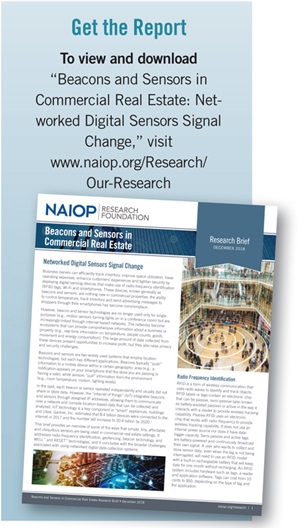Smart Sensors in Commercial Real Estate: The Next Generation

A new research brief explores the uses — and concerns — of technologies that gather and transmit massive amounts of data.
Beacons and sensors — digital devices that can collect and transmit vast amounts of information via radio-frequency identification (RFID) tags, Wi-Fi and smartphones — are making it easier than ever for business owners to track inventory, improve space utilization, lower operating expenses, enhance customer experiences and tighten security. However, turning huge amounts of data into actionable information can be a challenge, and many privacy issues are still being worked out.
A new research brief published by the NAIOP Research Foundation titled “Beacons and Sensors in Commercial Real Estate: Networked Digital Sensors Signal Change” offers insight into some of the ways that simple, tiny, affordable and ubiquitous sensors are being used in commercial real estate settings, as well as identifying the broader challenges associated with using networked digital data-collection systems.
How They Work
Beacons and sensors connected to the “internet of things” (IoT) can help the CRE industry make fine-tuned, data-driven decisions to increase operational efficiencies and improve experiences for tenants and customers. For example, in addition to tracking the movement of goods and people in warehouses or hospitals, IoT-connected beacons and sensors can monitor equipment and report on conditions such as indoor air quality. Data continuously streaming from these devices enables real-time analysis and visualization.
This integration with IoT will connect an estimated 20.4 billion “smart” technologies by 2020, according to Gartner, Inc.
Beacons typically “push” information to a mobile device within a certain geographic area (e.g., a notification appears on smartphones when customers pass a store having a sale), while sensors “pull” information from the environment (e.g., room temperature, motion, lighting levels).
Beacons and sensors are becoming more sophisticated. Instead of a single sensor performing one task, such as motion-detector lighting in conference rooms, devices are now networked to each other, connected to the internet, and collecting data that can be analyzed in many ways. The data collected are becoming increasingly valuable because they can be monetized or used to improve outcomes.
However, the technology is changing so rapidly that keeping up with how to collect, store and protect data, and deciding which hardware and software systems to use, can be overwhelming. To speed up decision-making and reduce risk, companies are hiring IoT consultants who advise them about where to locate and connect sensors, as well as how to manage the data.
The use of sophisticated devices to monitor and assess environments, despite the challenges, will continue to bring about transformation in commercial real estate. As the rate of adoption increases, material and implementation costs will decrease and approaches will become standardized. Data privacy and protection will continue to remain a primary concern, even with increasing regulations.
The Underlying Technologies
Many beacons and sensors use technologies such a GPS, Bluetooth™, radio waves and Wi-Fi to gather and transit information. RFID, an older form of tracking technology, uses radio waves to identify and track tagged objects. RFID is widely used to determine the location and identity of workers and equipment on construction sites, as well as enable robot pickers in warehouses to fill retail orders.
Geofencing makes use of GPS-enabled smartphones to determine when a person has entered into a geographic boundary or perimeter. For example, JLL developed PinPoint, a tool to monitor shoppers within a geofence at shopping centers the company manages or leases. The data collected by the geofence interface provides an exact count of foot traffic, as well as accurate and quantifiable examples of consumer behavior.
Beacons are used in location-based messaging and tracking, but the platform generally relies on Bluetooth technology rather than cellular or Wi-Fi networks. Beacons also have a smaller target range than a geofence. Initial beacon applications were limited to retail settings, but they are increasingly being used in other industries such as manufacturing, logistics and health care.
The WELL Building Standard has partnered to combine its performance-based system for measuring, certifying and monitoring features of the built environment that impact human health and well-being (such as air and water quality, optimal lighting and availability of fresh food) with GIGA’s RESET ™ environmental sensors and cloud-based analytics. The sensors, placed around various locations within a building, collect ambient data and store it in a secure server where it can be analyzed and used toward building wellness certification.
Get the Report
To view and download “Beacons and Sensors in Commercial Real Estate: Networked Digital Sensors Signal Change,” visit www.naiop.org/Research





